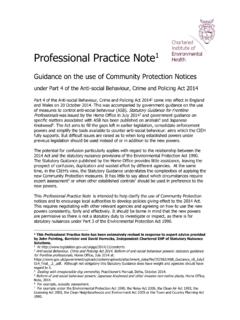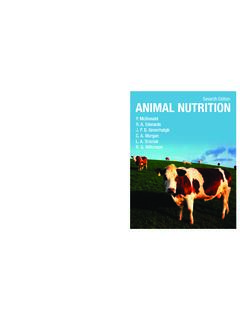Transcription of Health and safety in horse riding establishments and ...
1 Health and safety in horse riding establishments and livery yards WHAT YOU SHOULD KNOW. KAREN and MICHAEL SINCLAIR-WILLIAMS. December 2015. Health AND safety IN horse riding establishments AND LIVERY YARDS. WHAT YOU SHOULD KNOW. FOREWORD TO THIS PUBLICATION. The CIEH published the original guidance document a number of years ago to help communication and ultimately enhance the safety of the sport and leisure time activity of equestrianism. It was felt timely to update the publication and make it more useful to a wider audience in light of some changes and developments. There has been some very positive feedback from users since its original publication and therefore it is believed there is still a demand for information and knowledge in this subject. Following a period of consultation and useful feedback and input for which the authors are very grateful, the document has been updated in line with revised legislation, enhancements in good practices and developments in equipment that have improved safety protection.
2 This version also includes a number of web links to relevant sources of information. ACKNOWLEDGMENTS THE AUTHORS. Chartered Institute of Environmental Health (CIEH) Michael Sinclair-Williams (Dr.) is a keen horseman with many years operational safety experience. Health and safety Executive (HSE) Local Authority Unit He holds a first degree, an MBA and a Phd in Total British horse Society (BHS) quality Management (TQM) and risk management. He is a Chartered Member of the Institution of National Companion Animal Focus Group Occupational safety and Health (CMIOSH). Pony Club Karen Sinclair-Williams is a Chartered member Tim Deveaux, CIEH Trustee of the Chartered Institute of Environmental Health Harry Paviour, Equine Fire safety (CMCIEH) with an MSc. She is on the British horse Society Register of Instructors and regularly teaches Mark Plummer, EHO. private clients and on behalf of local riding schools Spelthorne Borough Council and the Pony Club.
3 Thanks also to the following for allowing photographs Most importantly, both want their children to to be included; Bisley and Sandown Chase Pony Club, enjoy riding and return home safely. Langshot Equestrian, Countrywide Stores, Lyne Farm, Valley Lace Stables, The Mill, Hatch Farm Stables. Any products depicted are for illustrative purposes only and are not endorsed by the authors/CIEH. Disclaimer This document has been prepared in the best interests of animal welfare and Health and safety and to advise those tasked with the inspecting, advising and licensing of livery and stable yards. No responsibility or liability for loss or consequential loss occasioned to any person as a result of making use of this publication (including the recommended best practice contained within), is accepted by the CIEH, or the authors of this publication. It should also be borne in mind that laws change and expert advice should always be sought as to the legal position.
4 1. Health AND safety IN horse riding establishments AND LIVERY YARDS. WHAT YOU SHOULD KNOW. CONTENTS. INTRODUCTION 5 PART A ENVIRONMENTAL GENERAL. The horse as a social partner 5 MANAGEMENT SYSTEMS 19. Who is this publication aimed at? 6 Office 19. What is the challenge? 6 Stables 20. Hay/straw/bedding storage areas 21. CHAPTER ONE DEFINITIONS AND THE Yard/handling areas 21. LEGISLATIVE OVERVIEW 7 Muck heap 22. Definitions 7 horse walker 22. horses and ponies 7 Indoor school 22. Full livery 7 Outdoor schools 23. Part livery 7 riding fields 24. DIY livery 7 Cross country jumping areas 24. Working livery 7 Local bridle paths/ riding tracks 25. Does Health and safety legislation apply? 8 Fields for grazing 25. Responsibilities to employees 8 Weather and lightning 26. Others who may be affected 8. The responsibility of employees 8 PART B WORK PROCEDURE HAZARDS 27. The legislative requirements 8 Lessons 27.
5 Risk assessment 10 Pre assessment 27. Factors to consider 10 riding wear 27. Suitability of horses 28. CHAPTER TWO GROUPS AT RISK AND riding instructors 28. TYPICAL HAZARDS 11. The lesson itself 29. Who are the groups at risk? 11. Hacks/rides/treks 29. Staff 11. riding assessment 29. riding school clients 11. riding by employees/unsupervised clients 30. Members of the public 12. Selection of suitable horses for clients and Contractors 12 staff to ride 30. The hazards 12 Suitability for the roads 32. Hazard and accident data 14 Assessing the horse using tack as a guide 32. The risks 16 Handling horses 32. Experience and qualifications in handling CHAPTER THREE safety MANAGEMENT and dealing with horses 33. SYSTEM AND CONTROL 17 Loading horses into horse boxes or trailers 34. Catching/turning out horses 34. Lungeing 35. Tack 35. Tack design 35. Use of work related vehicles 36.
6 Tractors 37. All terrain vehicles 38. Safe use of agricultural mowers 38. Contractors 39. Members of the public/spectators 40. 2. Health AND safety IN horse riding establishments AND LIVERY YARDS. WHAT YOU SHOULD KNOW. CONTENTS CONTINUED. PART C RELATED safety PROCESSES 41 Manual handling - general 48. The Management Regulations 41 Manual handling - horses 48. New and expectant mothers 41 Manual handling - feed and bedding 49. Children and young people 41 Manual handling - deliveries 49. Provision and use of work equipment 42 Manual handling - tack 49. First aid/incident management 42 Manual handling - riding and jumps 49. Ratios of first aiders 43 Manual handling - doors and gates 50. The character and dispersion of the workforce/lone Mucking out 50. workers 43 More specific individual manual handling Distance from the workplace to emergency medical assessments 50.
7 Services 43 Asbestos in riding establishments /livery yards 50. Shared or Multi Occupied Sites 43 Electrical systems 51. Events 43 Substances harmful to Health 52. First aid equipment 44 Leptospirosis 53. Accident reporting and investigation-RIDDOR 44 Ringworm 54. Over-seven-day incapacitation of a worker 44 54. Over-three-day incapacitation 44 Tetanus 54. Non fatal accidents to non-workers (eg members of the Dust irritation/farmer's lung 54. public) 44. Exposure to hot or cold conditions 55. Falls from height 45. Display screen assessments 55. Personal protective equipment 45. Fire safety 55. riding hats 46. Competency and training 56. Body protectors 46. Communication 57. Footwear 47. Gloves 47. PART D MANAGEMENT RELATED safety . Coats and high visibility clothing 47 PROCESSES 58. Trousers 48 Checking 58. Other 48 Act 58. General 48. 3. Health AND safety IN horse riding establishments AND LIVERY YARDS.
8 WHAT YOU SHOULD KNOW. This guidance is a valuable tool for enforcement officers, vets, representatives of professional equine organisations and those responsible for complying with Health and safety legislation in riding establishments and livery yards. The diagrams and photographs clearly illustrate the key points for those people less familiar with horses and these types of premises . Percy Smith, HSE. 4. Back to contents Health AND safety IN horse riding establishments AND LIVERY YARDS. WHAT YOU SHOULD KNOW. INTRODUCTION. The horse as a social partner The industry is supported by a dedicated and active The horse has been part of man's development over trade association, the British Equestrian Trade many thousands of years. The relationship began at Association (BETA) ( ), which a time when work and travel were the primary goals. estimates that the UK equine industry supports a Today there are mechanical aids which are faster and multi-billion pound revenue stream, employs a quarter more effective, so the function of the relationship has of a million people and provides approximately changed to predominantly one of leisure and sport.
9 Million people with a material leisure benefit. This also means that the user group has changed. Obviously, due to their size and needs, horses are not horses are now owned and ridden by people from all animals that can be kept in the average suburban walks of life, with varying degrees of experience but garden. This has resulted in a vast cottage industry of who still benefit from that interaction. livery stables and yards, ranging from simple fields to lavish self-contained stables. With few exceptions, most For example, horses are regularly used as part of urban people wishing to learn to ride take lessons at local horse experience programmes where children from deprived riding establishments (commonly referred to as riding areas are given access to a horse for a short period of schools). Those that maintain an interest in the sport time. Disabled groups also use interaction as a way of may continue in this way for many years, while others improving co-ordination skills and for therapeutic gain.
10 May eventually purchase their own horse or share a Both the young and old also use the horse for gaining horse with a second party. In the majority of cases they inner confidence, exercise and enjoyment. Therefore will keep the horse at some form of livery yard or riding it is clear that horses play a vital role for many, both school. To provide confidence in the quality of such psychologically and physically. establishments to members, the British horse Society (BHS) has established an approval/rating system that evaluates how they are managed from an equestrian To better understand the magnitude of the sector, the perspective. The Association of British riding Schools following facts are worth consideration: (ABRS) also run their own approval system. It should be noted however that many establishments do not million people in Great Britain rode horses in 2015.







